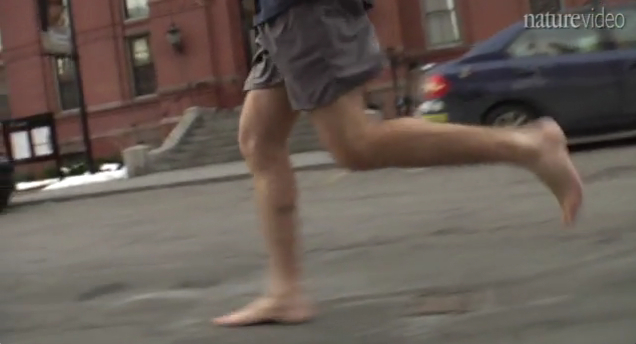Guest blog by George Murley
There is an increasingly strident debate on the use of minimalist/barefoot versus traditional sports footwear in running, and there appear to be advocates for both sides who believe there is no need for a rational discussion.

The debate appears to have escalated following publications by Richards and colleagues (2008) ‘Is your prescription of distance running shoes evidence-based?’ and later by Lieberman and colleagues (2009) ‘Foot strike patterns and collision forces in habitually barefoot versus shod runners’ and McDougall’s book — ‘Born to Run.’
The main issue in this very messy debate seems to be whether ‘some’ barefoot/minimalist shoe running is beneficial. This is related to the first vertical impact force, minimalist shoes are meant encourages a forefoot strike and decrease this force, which in turn dampens the first vertical impact force. This however has some individuals suggesting that running barefoot may lead to injuries related to loading of the Achilles and direct impact of the forefoot. A second part of the argument is that footwear is supposed to weaken foot muscles whereas barefoot running challenges muscles and presumably leads to stronger/hypertrophied muscles that in turn have a positive effect of function.
Clinically we are primarily interested in the effect on injury. There are strong views and some limited evidence supporting arguments about the relationship between the first vertical impact force and injury. One perspective is that first vertical impact force causes injury whereas others argue injury is related to the ‘active’ forces of push off.
There are a ton of unanswered questions:
Does athletic shod or unshod running affect injury risk?
How does shod and unshod running interact with comfort and performance?
Which biomechanical parameters are related to injury risk?
Does footwear or unshod running reverse biomechanics parameters related to injury risk?
What is important is that clinicians and scientists approach this debate in a reasoned and calm way as there may be merit in both sides of the argument. Having only one perspective and fighting amongst ourselves is not necessarily going to help answer the questions or help the sportspeople make informed decisions about their footwear.
References:
Podiatry Arena (extensive blogging on this issue)
The Barefoot Professor: by Nature Video
Author Chris McDougall’s book — ‘Born to Run’
Related BJSM Blog
To Strike or Not to Strike? That’s not the only question (for running and injury prevention)
***********************************************
Dr George Murley is a Podiatrist who graduated from La Trobe University with Honours in 2002. He then commenced teaching at La Trobe and completed his PhD related to the effect of foot posture and foot orthoses on lower limb muscle activity. Dr Murley was awarded the Stephen Duckett Higher Degree Research Prize for best PhD thesis in the Faculty of Health Sciences in 2010.